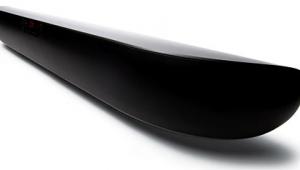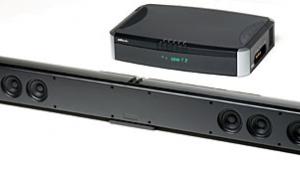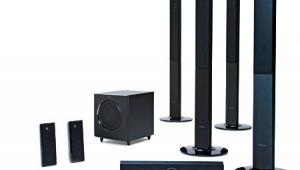Dreaming the Not-Impossible Dream Page 3
The $4,000/pair XR50 stand-mount monitors (used here as surrounds) feature similar drivers as used throughout the line, but in a vertical stack consisting of a single, rear-ported woofer and an MTM array.
Setup
I managed to unbox and hoist the MC8207 amplifier atop my Salamander A/V cabinet along with the other components, but waited for the regional McIntosh representative to arrive to help unbox the speakers and assist with the setup. The amplifier’s physical wow factor didn’t diminish during the entire
review cycle.
Speaker placement didn’t prove to be as critical as with some systems reviewed in Home Theater. Nor was toe-in, thanks to what sounded to me to be the tweeters’ smooth and wide dispersive character and well-behaved, off-axis power response.

Configuring the MX121 was a snap because the interface was pretty much identical to that of my reference Marantz AV7005. I’m going to save space here and recommend you read that review (Home Theater, April 2011, or HomeTheater.com) if you want more set-up, functionality, and operational details because they are, for the most part, identical.
Let’s just say, I did not use any of the video adjustments, nor did I attempt to make use of the custom, multiband EQ settings. Most of the time this kind of play results in worse, not better, picture and sound quality. From within the MX121’s speaker configuration menu, the XR100s were set to Large and the others to Small. Initially, I ran the system as is without the Audyssey room-correction engaged. McIntosh supplies a nice microphone stand to use with the Audyssey microphone. A bit much? Perhaps (and cynics might say for $6,000, the company could also throw in another kind of Mac-Intosh), but if you don’t already have a tripod, it is handy.
McIntosh also supplied its own balanced interconnects for the processor-to-amp connections, and I made sure to run a set of balanced cables from the MVP891’s balanced stereo outputs to the MX121’s balanced inputs. Twelve-volt triggers turn on both the amp and the player at preamp startup, and just to add an additional bit of bling, you can run supplied low-voltage cables to the front and surround speakers, and upon preamp turn-on, the speakers’ McIntosh logo will glow a cool green.
Watch and Listen
The setup was all taking place
in my living room. My wife is somewhat tolerant, but when she got home from work that evening and saw the “stuff” on top of the A/V cabinet, she was not happy!
“I thought you bought that so those things could go inside, not on top!” she exclaimed. “How long will those be…oh, those are nice!”

So before I describe the system’s sonic performance on movie soundtracks, let me just say that when I told her a month later that the McIntosh rep was coming the next day to help box everything up, her response was, “Can we buy this? Can we keep it?”
Why the flip-flop? She got used to the sound, pure and simple. I know some audiophiles who, when they think “McIntosh,” mistakenly think “Lincoln Town Car.” They think warm, soft, and squishy—not exactly what you want in a home theater system.
But this one was all Ferrari and no Town Car. It produced soundfields that were astonishingly transparent, tight, vibrant, focused, punchy, dynamic, and most of all, utterly effortless—at any volume I cared to listen at.
 The first Blu-ray Disc we watched was Wes Anderson’s talky, adult, stop-action-
animation feature Fantastic Mr. Fox, featuring the voices of George Clooney, Meryl Streep, Jason Schwartzman, and Bill Murray. It’s animated but not cartoonish, so the dialogue delivery is subtle, fast-paced, and almost under-the-breath matter of fact. Clooney voices a scheming, quick-witted fox—is there any other kind?—and that’s the movie’s underlying point. He’s behaving as only a fox can, no matter how much he tries to
act otherwise.
The first Blu-ray Disc we watched was Wes Anderson’s talky, adult, stop-action-
animation feature Fantastic Mr. Fox, featuring the voices of George Clooney, Meryl Streep, Jason Schwartzman, and Bill Murray. It’s animated but not cartoonish, so the dialogue delivery is subtle, fast-paced, and almost under-the-breath matter of fact. Clooney voices a scheming, quick-witted fox—is there any other kind?—and that’s the movie’s underlying point. He’s behaving as only a fox can, no matter how much he tries to
act otherwise.
The clarity, cleanliness, and tonal coherence with which the system delivered the dialogue was immediately obvious. Male voices were noticeably free of chesty overhang, yet still timbrally full-bodied, and the rapidity and completeness of the decay helped produce remarkable intelligibility.
The balance of chest, voice box, and mouth were perfectly balanced and integrated, much as they were with the much larger Adam Audio GTC77 center channel I reviewed in the February 2012 issue. This is the first relatively small, center-channel speaker I’ve heard that achieved a similar result.
I like to listen at relatively high, im- mersive SPLs. My wife prefers just the opposite, so you have to listen in rather than having the sound project toward you. I normally find that requires a kind of concentration in which I’d rather not involve myself when I’m watching a movie. More often than not, intelligibility suffers and sonic coherence breaks down at lower SPLs, as you either hear a muffled midbass protrusion or vocal sibilants predominate.
Yet, listening at my wife’s preferred low volume, there was little or no change in either intelligibility or vocal coherence—even though Clooney’s character maintained a low monotone throughout. I did turn it up a few times—once or twice way up—because our dog barked incessantly and quizzically at the suit-wearing fox and no speaker could cut through that at moderate SPLs. Even at these levels, though, dialogue remained equally clean, coherent, and intelligible, and never sounded strained or boxy. Big speakers can achieve this, but it’s rare that a smaller one can.





























































